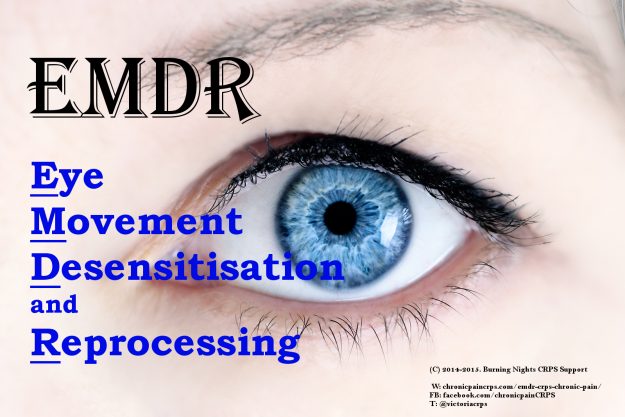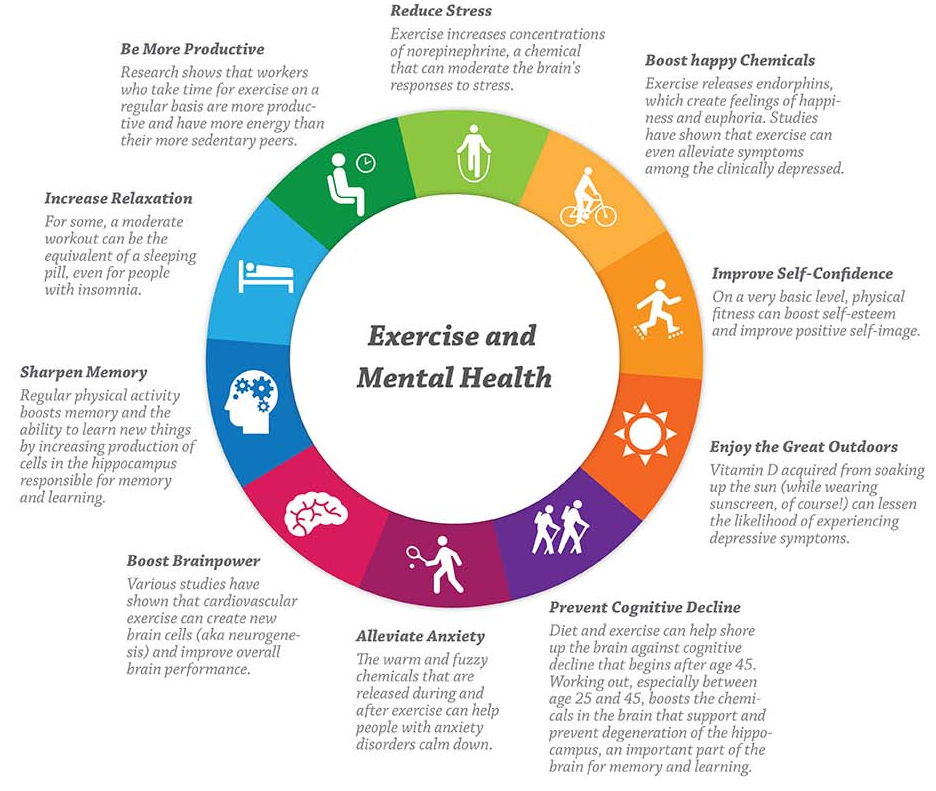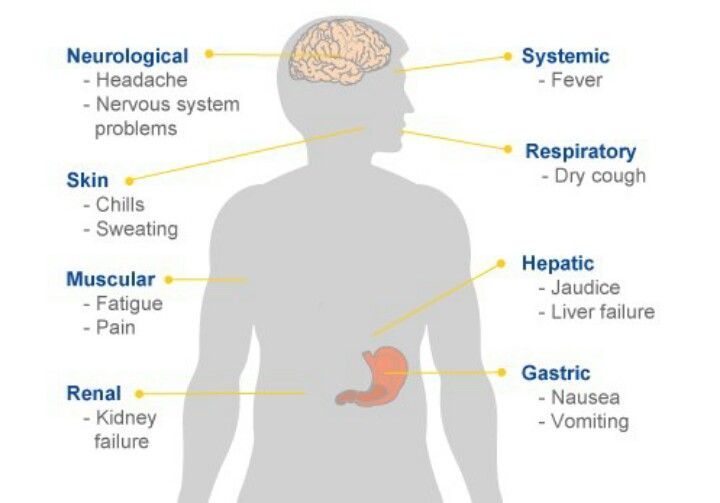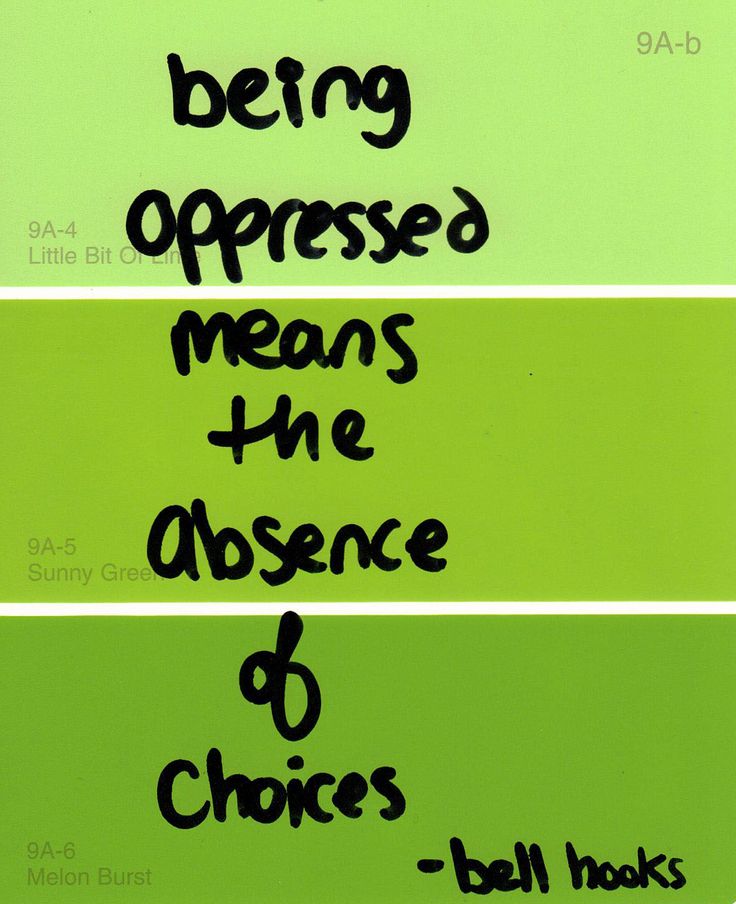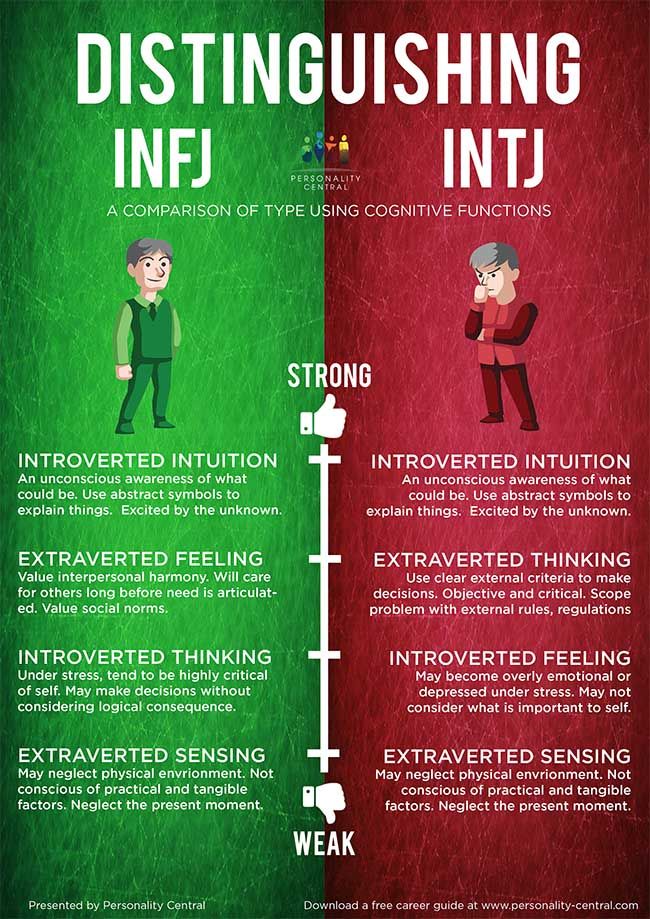What are the five personality traits
What Are The Big 5 Personality Traits?
Many modern and traditional studies in psychology point to 5 basic dimensions of personality. Evidence of this theory has grown over the years with the principle theory emerging in 1949. The five broad personality traits described by the theory are extraversion (also often spelled extroversion), agreeableness, openness, conscientiousness, and neuroticism.
The five basic personality traits is a theory developed in 1949 by D. W. Fiske (1949) and later expanded upon by other researchers including Norman (1967), Smith (1967), Goldberg (1981), and McCrae & Costa (1987).
Researchers had spent years before trying to pin down character traits as a way of analysing people’s behaviour. At one point, Gordon Allport found over 4000 traits. Even when this was reduced to 16 it was seen as too complicated. This is where the five big personality traits began.
These broad categories have been researched and developed over the years and, whilst there is extensive study into each area, researchers don’t always agree on the definition of each characteristic.
What are the big five personality traits?
Openness
Openness is a characteristic that includes imagination and insight. The world, other people and an eagerness to learn and experience new things is particularly high for this personality trait. It leads to having a broad range of interests and being more adventurous when it comes to decision making.
Creativity also plays a big part in the openness trait; this leads to a greater comfort zone when it comes to abstract and lateral thinking.
Think of that person who’s always ordering the most exotic thing on the menu, going to different places and having interests which you would never have thought of… that is someone who has a high openness trait.
Anyone low in this trait tends to be viewed with more traditional approaches to life and may struggle when it comes to problem solving outside their comfort zone of knowledge.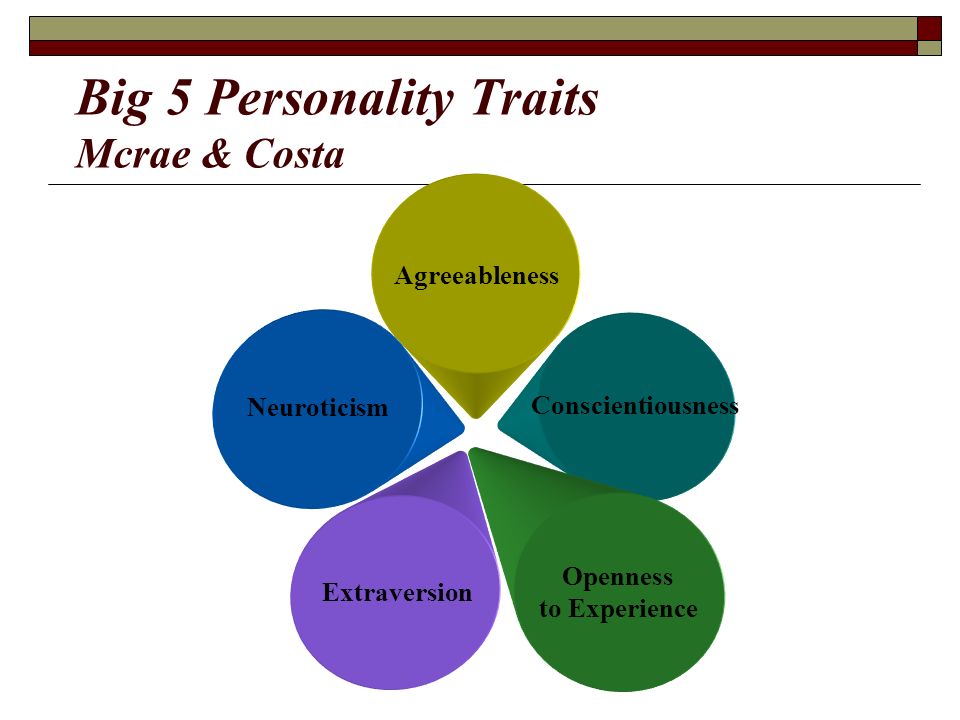
Conscientiousness
Conscientiousness is a trait that includes high levels of thoughtfulness, good impulse control, and goal-directed behaviours. This organised and structured approach is often found within people who work in science and even high-retail finance where detail orientation and organisation are required as a skill set.
A highly conscientious person will regularly plan ahead and analyse their own behaviour to see how it affects others. Project management teams and HR departments regularly have highly conscientious people working in their teams to help balance out the structural roles within the overall team development.
A good example of a conscientious person would be someone you know who is always planning ahead for the next time you meet - and in the meantime, regularly staying in contact, checking in on your wellbeing. They like to organise around certain dates and events and are focused on you when you meet.
People low in conscientiousness tend to dislike structure and schedules, procrastinate on important tasks and fail to complete tasks as well.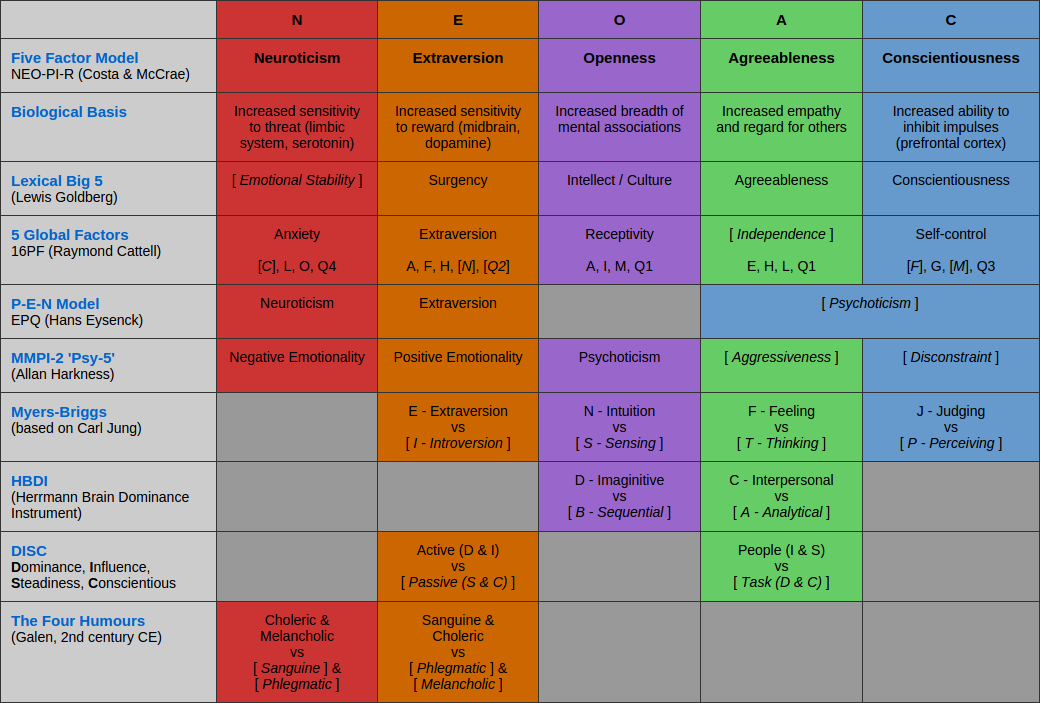
Extraversion
Extraversion (sometimes referred to as Extroversion) is a trait that many will have come across in their own lives. It’s easily identifiable and widely recognisable as “someone who gets energised in the company of others.”
This, amongst other traits which include, talkativeness, assertiveness and high amounts of emotional expressiveness, have made extraverted people widely recognisable over many years of social interaction.
We all have that one friend or family member - or several - who aren’t exactly wall flowers in a social interaction. They thrive on being the centre of attention, enjoy meeting new people and somehow tend to have the biggest friends and acquaintance group you have known.
The opposite is, of course, someone else in our lives we may know, an introvert. They prefer solitude and have less energy in social situations. Being at the centre of attention or making small talk can be quite taxing.
Extroverts tend to have very public facing roles including areas such as sales, marketing, teaching and politics.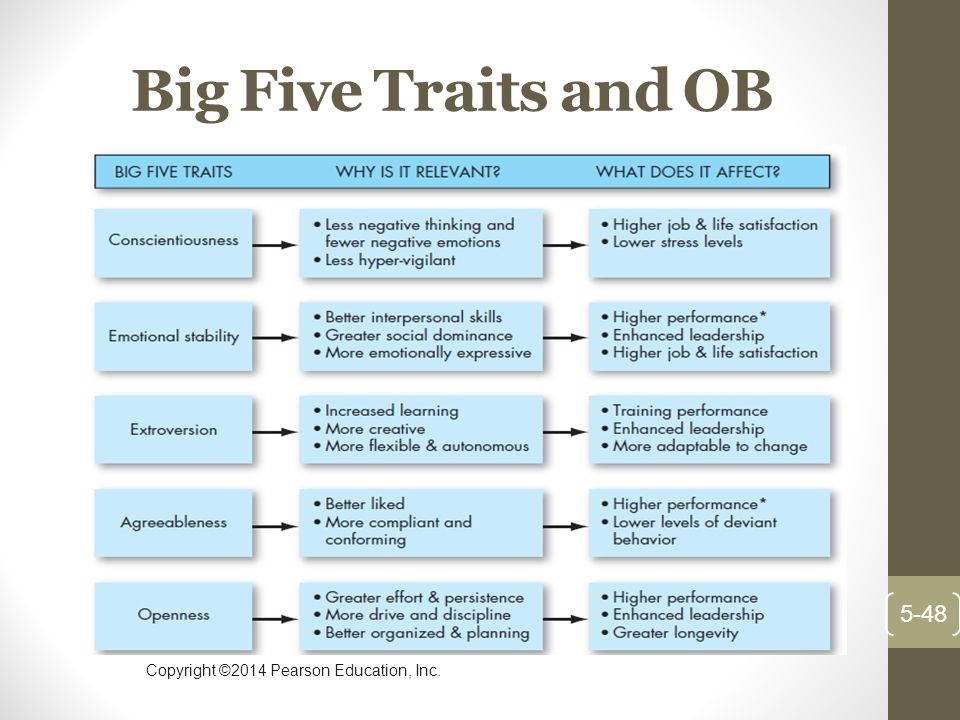 Seen as leaders, extroverted people will be more likely to lead than stand in the crowd and be seen to not be doing anything.
Seen as leaders, extroverted people will be more likely to lead than stand in the crowd and be seen to not be doing anything.
Agreeableness
People who exhibit high agreeableness will show signs of trust, altruism, kindness, and affection. Highly agreeable people tend to have high prosocial behaviours which means that they’re more inclined to be helping other people.
Sharing, comforting and cooperating are traits that lend themselves to highly agreeable personality types. Empathy towards others is commonly understood as another form of agreeableness even if the term doesn’t quite fit.
The opposite to agreeableness is disagreeableness but it manifests in behaviour traits that are socially unpleasant. Manipulation and nastiness towards others, a lack of caring or sympathy, a lack of taking interest in others and their problems are all quite common.
Agreeable people tend to find careers in areas where they can help the most. Charity workers, medicine, mental health and even those who volunteer in soup kitchens and dedicate time to the third sector (social studies) are high in the agreeableness chart.
Neuroticism
Neuroticism is characterised by sadness, moodiness, and emotional instability. Often mistaken for anti-social behaviour, or worse a greater psychological issue, neuroticism is a physical and emotional response to stress and perceived threats in someone’s daily life.
Individuals who exhibit high levels of neuroticism will tend to experience mood swings, anxiety and irritability. Some individuals who experience sudden changes in character from a day-to-day perspective could be highly neurotic and respond to high stress levels in their work and personal lives.
Anxiety, which plays a large part in the makeup of neuroticism, is about an individual's ability to cope with stress and perceived or actual risk. People who suffer with neuroticism will overthink a lot of situations and find difficulty in relaxing even in their own space.
Of course, those who rank lower on the neurotic level will exhibit a more stable and emotionally resilient attitude to stress and situations.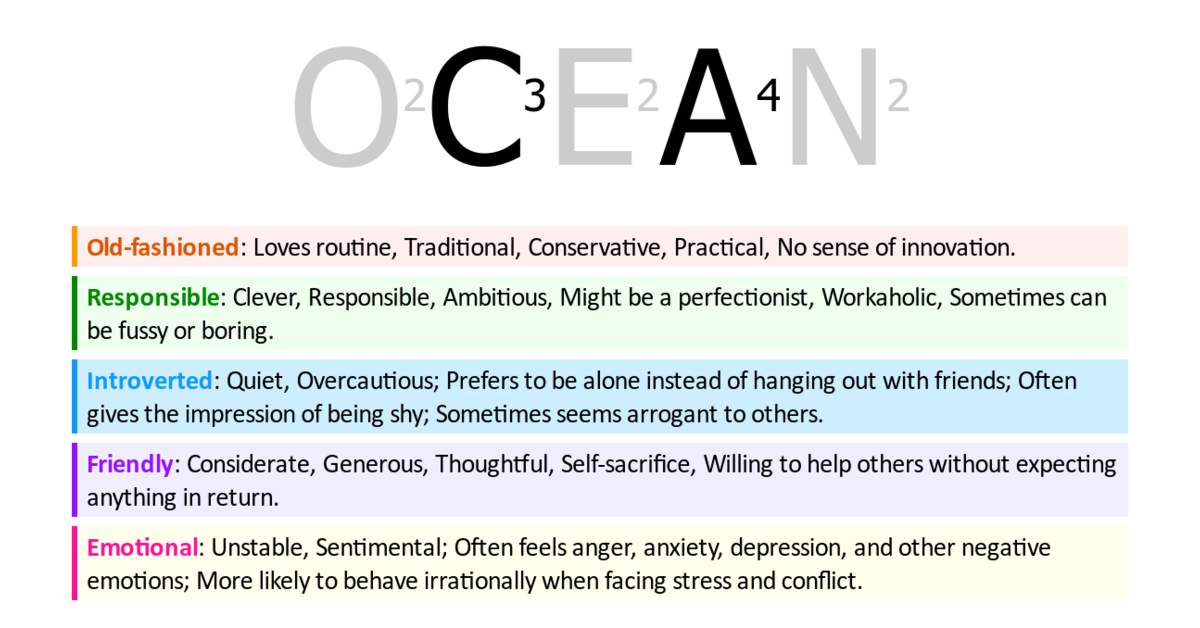 Low neurotic sufferers also rarely feel sad or depressed, taking the time to focus on the present moment and not get involved in mental arithmetic on possible stress-inducing factors.
Low neurotic sufferers also rarely feel sad or depressed, taking the time to focus on the present moment and not get involved in mental arithmetic on possible stress-inducing factors.
Who developed the big 5 personality traits?
Originally developed in 1949, the big 5 personality traits is a theory established by D. W. Fiske and later expanded upon by other researchers including Norman (1967), Smith (1967), Goldberg (1981), and McCrae & Costa (1987).
It’s suggested that as early the late 19th century social psychologists were trying to gain a more scientific understanding of personality but it wasn’t until the first official study in the 1930s by Gordon Allport and Henry Odbert that personality had some sort of scientific acknowledgement. They took 18,000 words from Webster’s Dictionary to describe personality traits and found adjectives that described non-physical characteristics creating a 4500 word bank of observable behaviour markers.
Later studies were able to identify many overlaps and specific traits per person which has allowed a more condensed and comprehensive review of personality traits.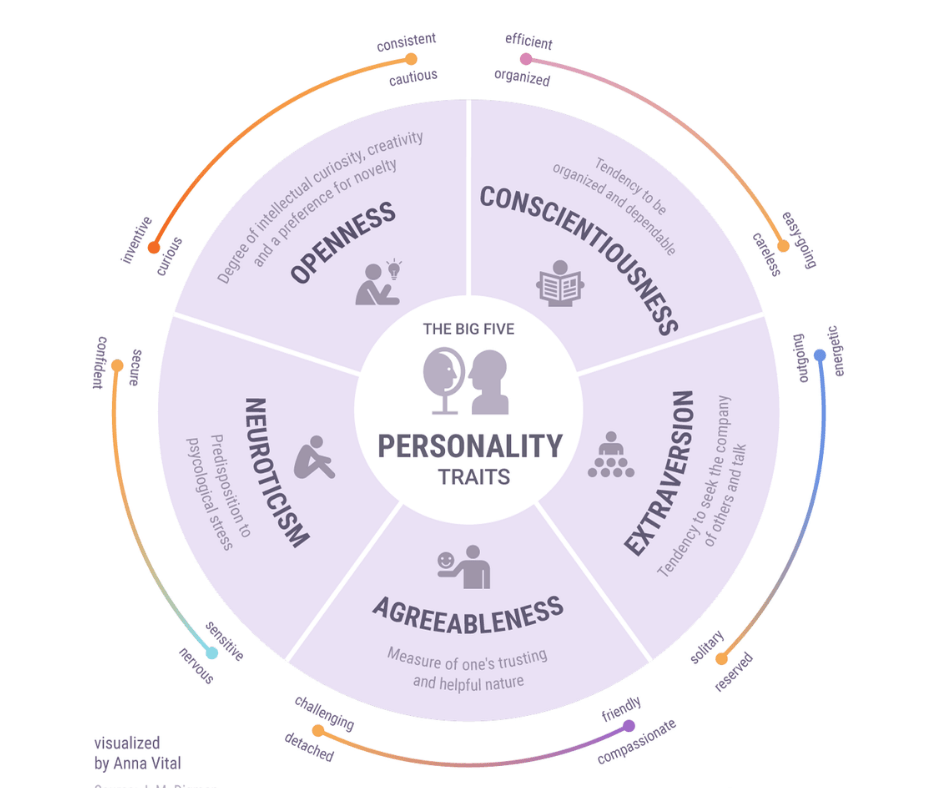 The big 5 are still widely used today as the basis of global study.
The big 5 are still widely used today as the basis of global study.
Why are the big 5 personality traits important?
When thinking about the big 5 personality traits, hiring managers, CEOs and even the candidates are wise to think about why they are important when it comes to joining a team. Before we go into the reasons why they are important, let’s quickly remind ourselves of what they are.
The five broad personality traits described by the theory are extraversion (also often spelled extroversion), agreeableness, openness, conscientiousness, and neuroticism.
The five basic personality traits is a theory coined in 1949 by D. W. Fiske (1949) and later expanded upon by other researchers including Norman (1967), Smith (1967), Goldberg (1981), and McCrae & Costa (1987).
So, why are they important when it comes to candidate selection?
The big 5 personality traits help us to not only better understand how they compare to others and to put names to their characteristics, it’s also used to explore relationships between personality and many other life indicators.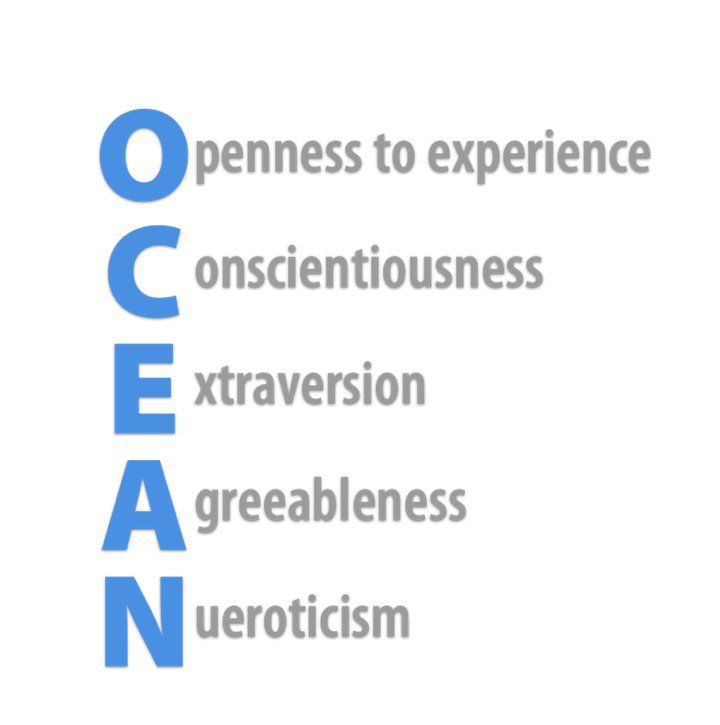
Think about knowing how agreeable your personality is and what this means to co-worker relationships? Or how neuroticism may have an impact on work-life balance? Overall, however, we can begin to break down why they’re important in different areas such as;
Understand employee relationships
How will people get along? Are you building a team where communication or trust may be stifled or open? Will you have a member of the team who can relate to others and be conscientious with others?
More effective team building and management
High five tendencies in openness, agreeableness and even extroversion can lead to better team management and team building. Someone who exhibits high agreeableness for example is capable of being cooperative, trustworthy and straightforward, making them easy to work with but also, showing the necessary skills for effective team management.
Understand employee motivations
Low five tendencies in something like extroversion can be difficult for understanding employee motivations.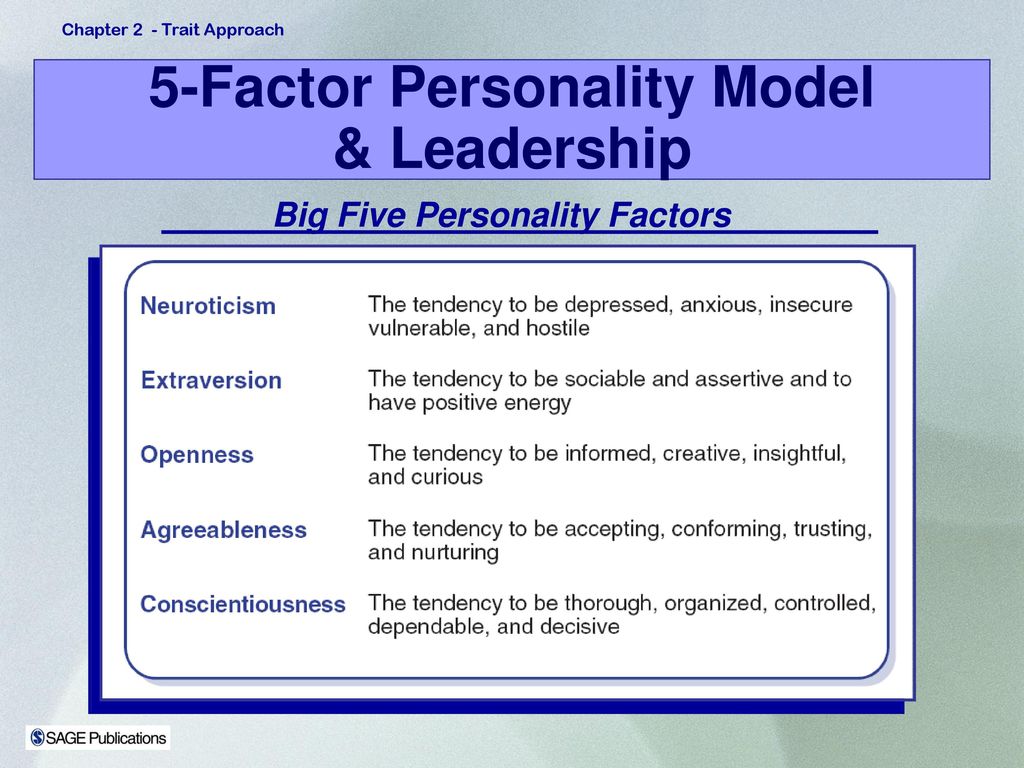 Whilst having a high-five tendency in agreeableness which encompasses empathy, makes it easier to get to the root causes of motivations and even gain a better understanding of people generally.
Whilst having a high-five tendency in agreeableness which encompasses empathy, makes it easier to get to the root causes of motivations and even gain a better understanding of people generally.
Build diverse teams
Something such as high-openness where embracing differences and embracing challenges can lead to more openness about who is hired, and finding solutions in different ways and areas. Whilst a team made up of mostly conscientious individuals is a team formation with the highest chance of being successful.
These teams will often display a good work ethic, produce high-quality work and be cooperative. This in return will lead to more solutions being put forward about who is required and where diverse teams can be built over time to help answer these problems.
Optimise interactions and communication
Again, something like high extroversion personality traits would be essential in developing interactions whilst being highly agreeable is better suited to open communications.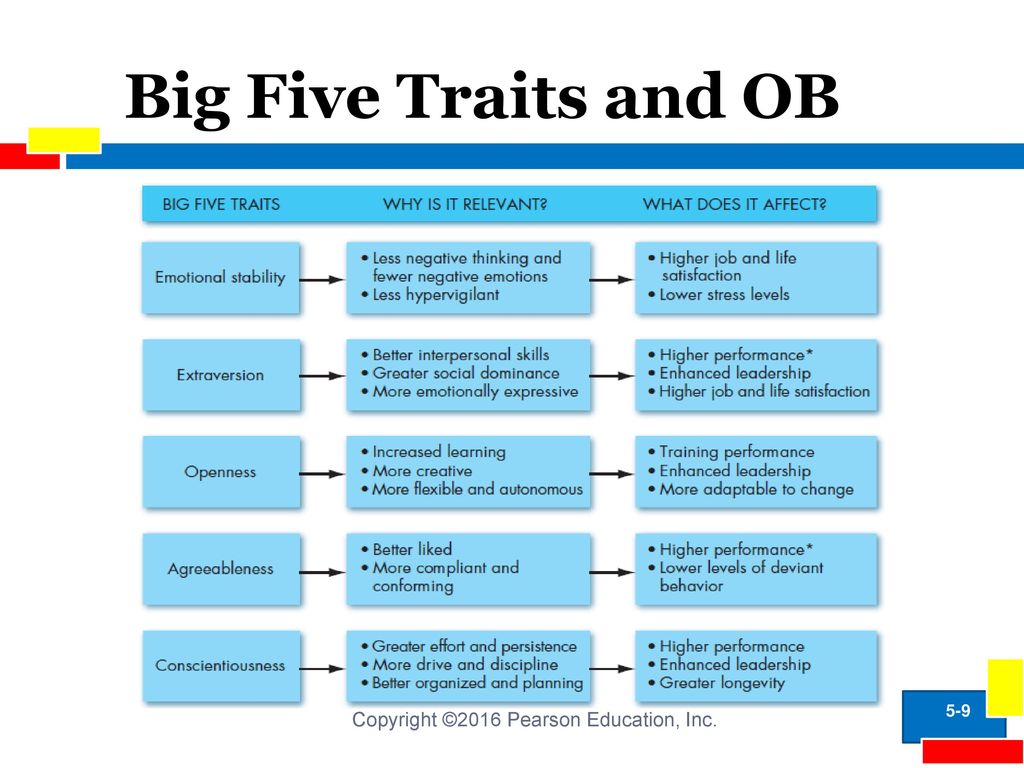
What factors influence the big 5 traits?
From nature and nurture to age and maturation, the big 5 traits have been widely studied where we can see what influences their impact on a person’s behaviour and character.
Personality has often been hypothesised as a question of nurture or nature. One particular study looked at 123 pairs of identical twins and 127 pairs of fraternal twins. “The findings suggested that the heritability of each trait was 53 percent for extraversion, 41 percent for agreeableness, 44 percent for conscientiousness, 41 percent for neuroticism, and 61 percent for openness.”
It has also been widely recognised that the older we get, the more our behaviour traits will change. We become less extraverted, less neurotic, and less open to new experiences whilst our agreeableness and conscientiousness will grow as we get older.
Do men and women differ with the big 5 traits?
The general consensus is that men and women are actually more alike than what normative social science would have us believe. But as the title would suggest, there are some exceptions.
But as the title would suggest, there are some exceptions.
Weinsberg and DeYoung in 2011 studied the big 5 traits and in particular Gender Differences in Personality across the Ten Aspects of the Big Five. They concluded that women tend to score higher on Extraversion, Agreeableness, and Neuroticism than men.
Other studies have concluded that whilst the differences may be present, some traits are not extensively separate. Getting older will tend to align behaviour traits such as agreeableness and extraversion where both genders tend to score lower as time moves on.
Which big 5 personality types make the best leaders?
If you’re looking to build a great leader, then you need to consider the importance of the big 5 model as it will give you all the tools you need to understand where the leaders in your organisation may secretly be hiding.
For example, you may think that an extrovert may be a good leader. Although extraverts tend to show good leadership skills, be sociable and encourage discussions, research has suggested that too many extroverts in a team can actually cause a decrease in effectiveness.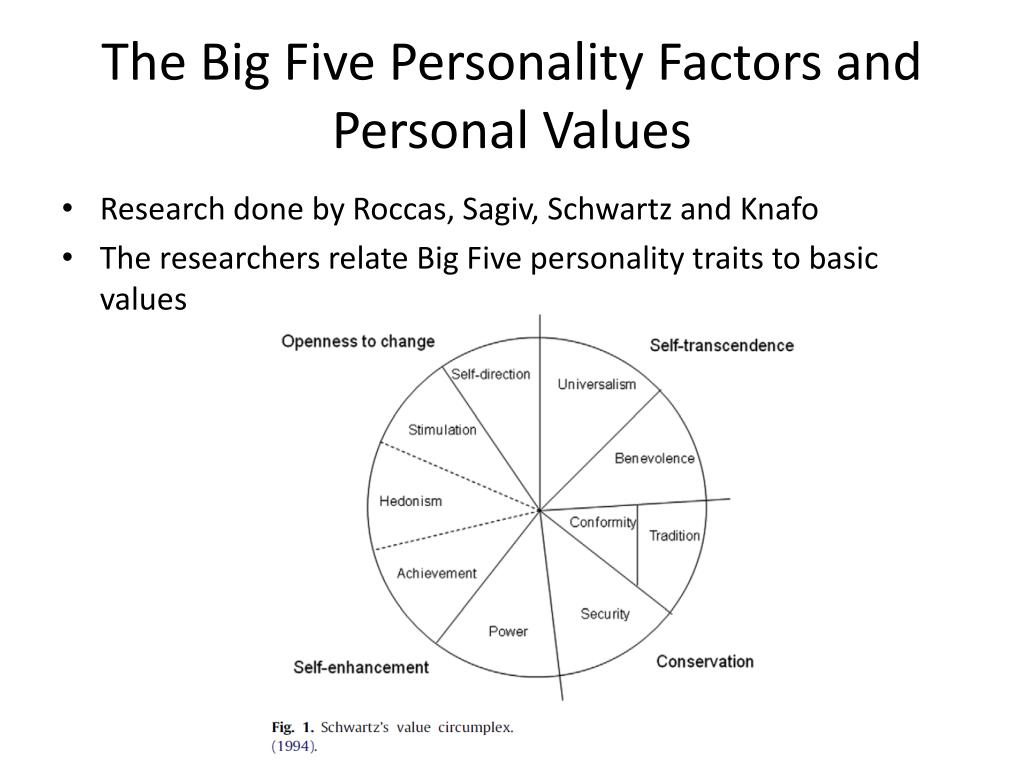
Whilst extroversion is typically the strongest characteristic, followed by conscientiousness, openness to experience, neuroticism and finally agreeableness being the least common, you want to think about what makes a good leader.
For example, conscientiousness, or self-discipline, is one of the most important factors in a leader, particularly under stressful situations when responsibility and reliability is pertinent.
What you get with a conscientious leader is someone who is diligent over individual tasks, and will stay with them until completed and therefore, trust is put in their direction as someone who is reliable. Something like being a reliable individual is also closely related to intelligence on the matter at hand. While there may be many other forms of intelligence that the individual may lack, knowledge about the relevant situation is key.
Openness to experience is important when leading a team. Leaders will find themselves in situations that are out of their hands, a constantly evolving situation where if there is an unexpected issue or there is something coming down the pipeline, their ability to take executive decisions is only a positive. There is also a level of creativity that comes with openness and in difficult situations or confusing times, a resourceful leader - usually high in openness is a benefit.
There is also a level of creativity that comes with openness and in difficult situations or confusing times, a resourceful leader - usually high in openness is a benefit.
The two of the big 5 least attractive to leadership roles are neuroticism and agreeableness. The former will find teams being led by someone unsure of the decisions being made and potentially worse, being scared about the decision being made so no decision is made at all. The latter may have more people skills but that doesn’t mean that they have leadership traits. They may find themselves pleasing people rather than actually keeping the task in mind.
One of the key components to all of this however is that the Big 5 is not definitive and does not mean leaders can be predicted based on personality types. Other factors are far more important to appointing and training leaders, but this is a helpful exercise for those looking to reach leadership positions.
Big 5 personality traits tests
We can successfully measure personality traits with different tools and techniques.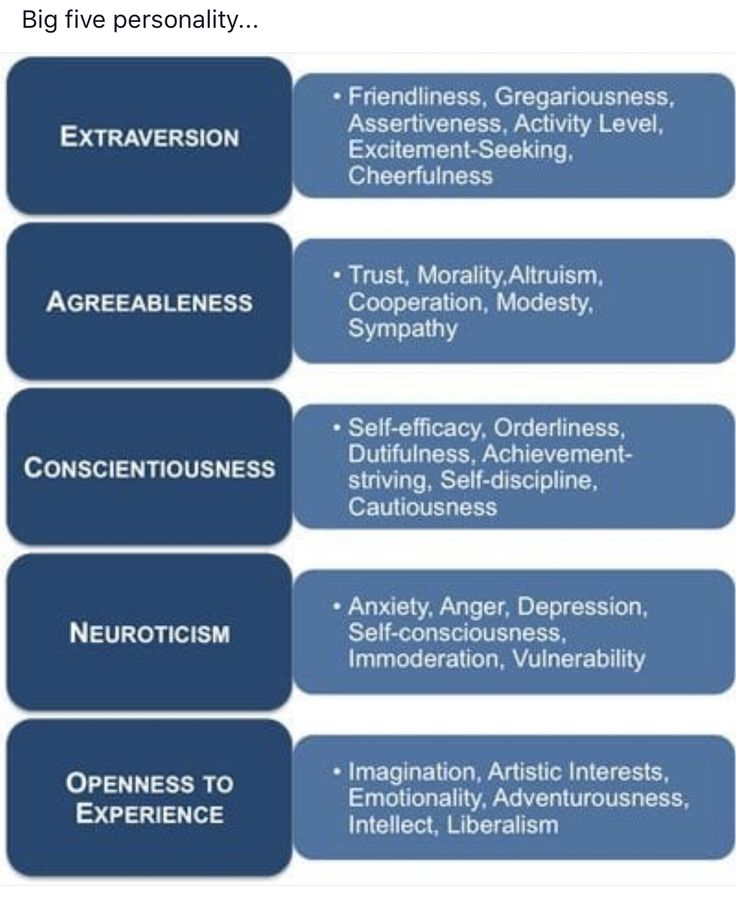 All in all, these tests are trying to discover how much your behaviour varies from high to low in the five traits which include; Openness, Conscientiousness, Extraversion, Agreeableness and Neuroticism.
All in all, these tests are trying to discover how much your behaviour varies from high to low in the five traits which include; Openness, Conscientiousness, Extraversion, Agreeableness and Neuroticism.
How are the traits measured?
Traditionally, a big 5 personality test is taken with a questionnaire and a multiple choice response.
For example, these questions will ask how much a person agrees or disagrees that he or she is someone who exemplifies various specific statements, such as:
- “Is open to trying new experiences” (for openness, or open-mindedness)
- “Is always thinking about others” (for conscientiousness)
- “Is the centre of attention at a party” (for extroversion)
- “Is trusting of others” (for agreeableness)
- “Is anxious about the future all the time” (for neuroticism, or negative emotionality)
The responses, Strongly agree to Strongly Disagree (with alternatives in between) will determine to what scale the person may be grouped into different personality traits.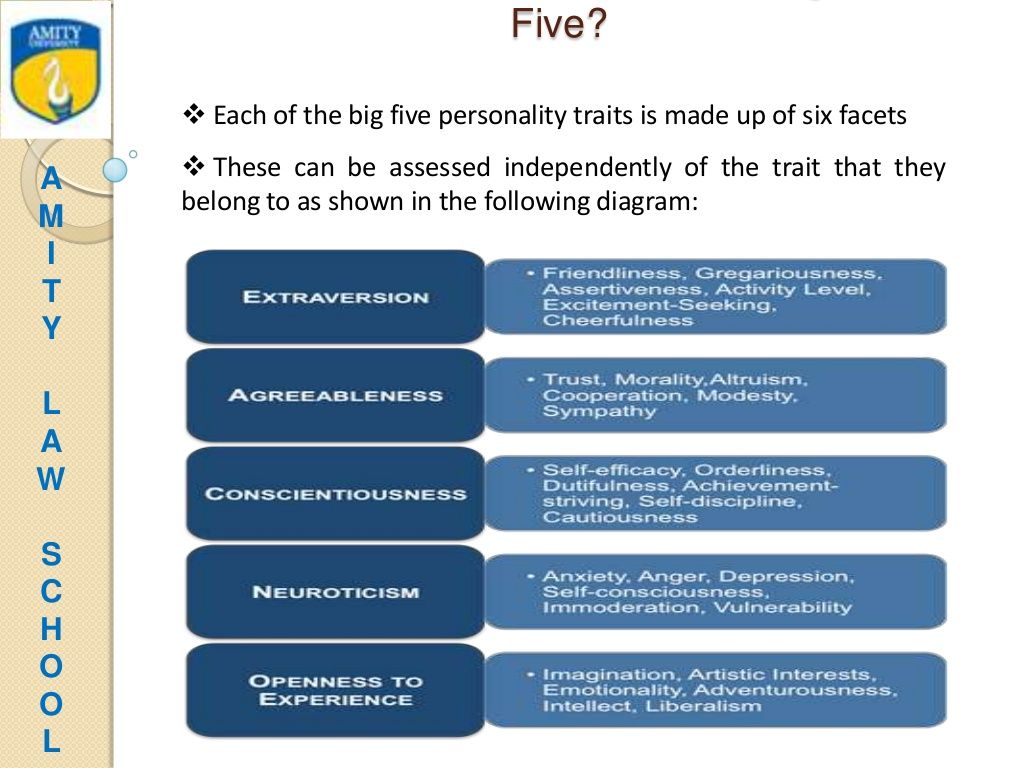
Are big five personality tests reliable?
Assessments based on the big 5 personality tests are very reliable, provided that sufficient research has been carried out and substantiated.
It is, to date, the most scientifically validated and reliable psychological model to measure personality. It is used to help predict behaviour as well as personality.
It remains a dependable model that businesses and scientific studies have been able to use consistently over a long period of time in helping to create new models, which predict someone’s behaviour at work, response to stressful situations and even understanding aspects of recorded social studies.
How do the big five personality traits predict behaviour at work?
When hiring employees (or testing current ones), the big 5 personality traits help us understand behaviour in the workplace and accurately predict, in many cases, future performance. Each personality type will have an impact within the working environment and amongst other staff.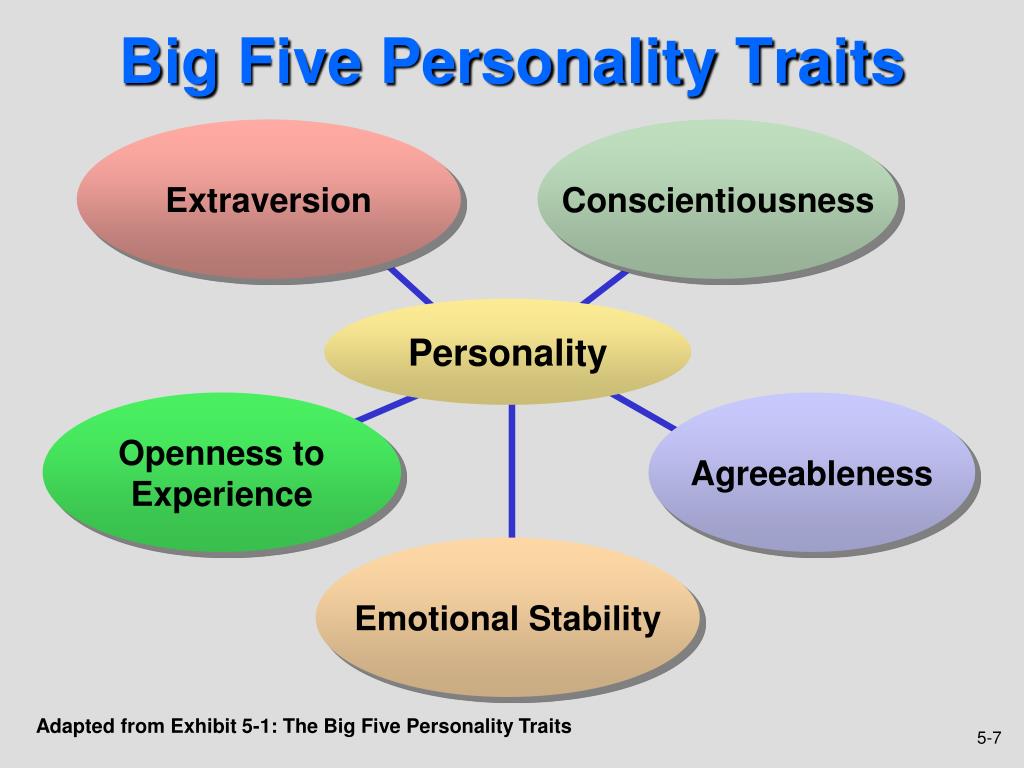 Being able to identify where there could be a positive or negative impact can help influence decisions around hiring or retaining staff.
Being able to identify where there could be a positive or negative impact can help influence decisions around hiring or retaining staff.
A candidate with a high openness score would be willing to learn new skills and tools. Presented with more abstract problems, they are more likely to think of abstract solutions and would be focused on tackling new problems that were perhaps previously overlooked.
Candidates with a high conscientiousness score wouldn’t necessarily be sat at their desk until midnight every evening! They would however be keen to get their work done, meet deadlines and be a self-starter; requiring little hand-holding to get the task done. Someone scoring low on the other hand, would need a lot more focus, time and attention to the task at hand.
The ideal extraversion scores would depend on the role you’re hiring for. Seen by many to be leaders in a team, a high extraversion score would do well in environments where they thrive off interaction with others:; sales, marketing & PR all require a level of people- facing skills.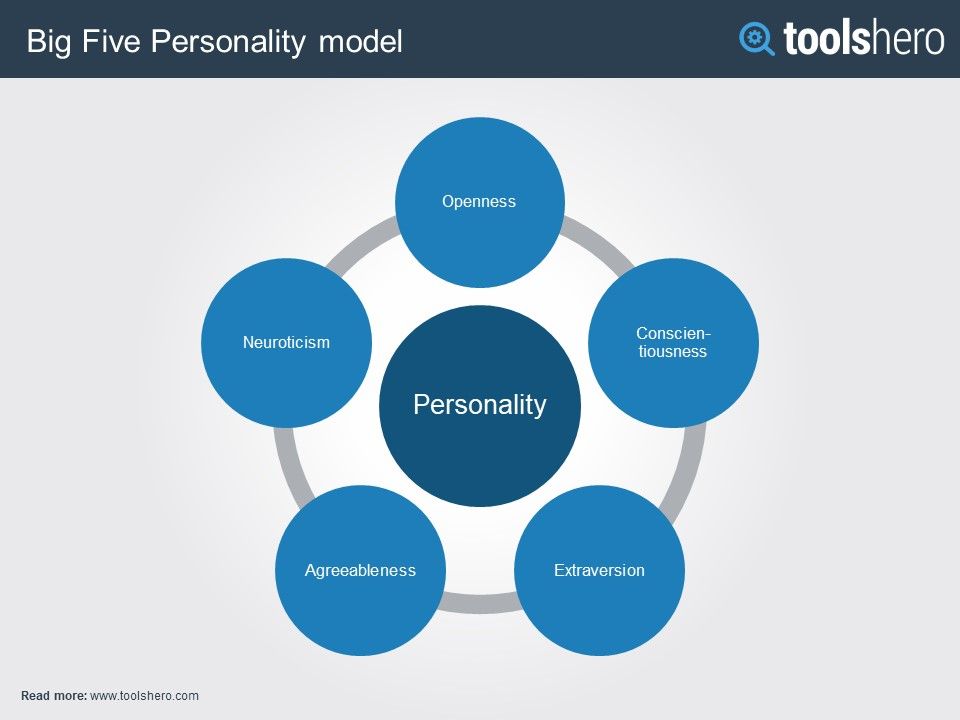 More technical job setups where specific focus or a degree of isolation is needed would, however, not be a good fit.
More technical job setups where specific focus or a degree of isolation is needed would, however, not be a good fit.
A candidate who shows high agreeableness would suit a role where personal skills and an ability to be at the service of others are needed. Of course, the opposite would be bad in a strong team environment and cause significant issues in order to work towards a common goal or task.
Finally, a candidate who exhibits high neuroticism will not be suited to a role where there are consistent changes, tasks that require strong self-starter tendencies or high stress levels. Those with low neuroticism scores will, however, thrive in these kinds of workplace scenarios.
These traits help us to understand how we may behave in the future, in our workplace and under certain circumstances as. For businesses, they can identify future talent, derailers and even potential for success.
How can Thomas help you find the right person for your role?
The Thomas Workplace Personality Test covers areas of personality testing based on Big 5 theory.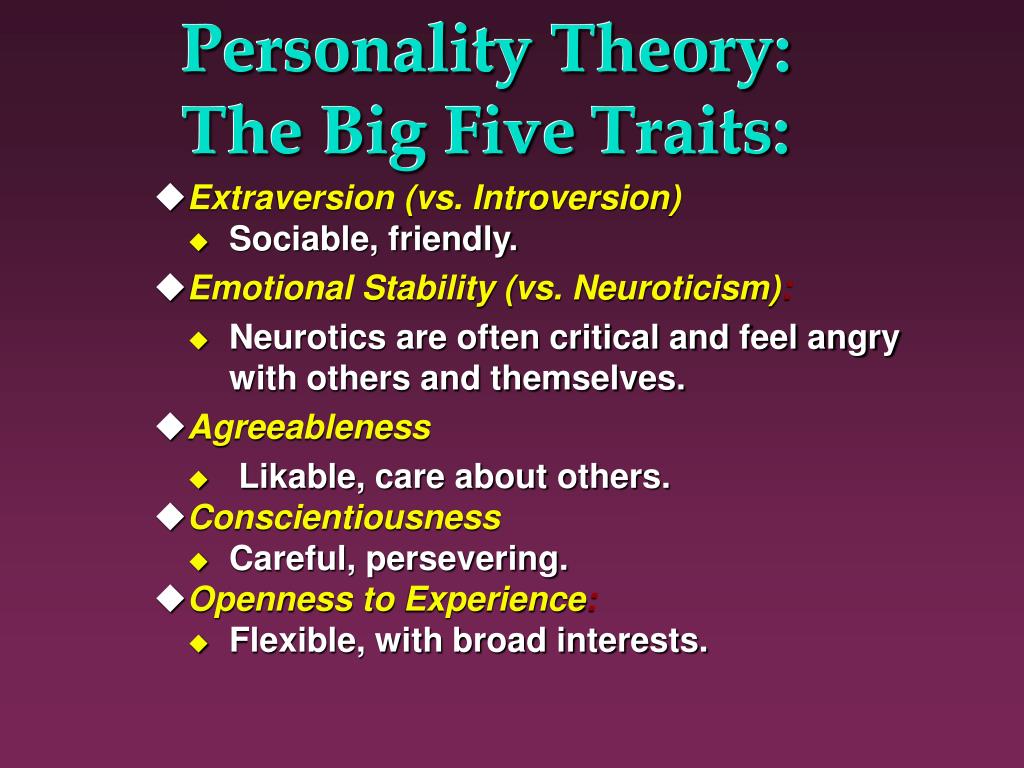 Also known as the High Potential Trait Indicator (or HPTI), it provides valuable insight into a person's strengths and potential derailers, including their leadership potential.
Also known as the High Potential Trait Indicator (or HPTI), it provides valuable insight into a person's strengths and potential derailers, including their leadership potential.
Developed by Ian MacRae and Adrian Furnham in 2006, the HPTI has been designed based on an ‘optimality’ model, which assumes that personality traits can be considered ‘optimal’ based on the requirements of a particular job role or position, such as senior executive leadership.
Based on a self-report questionnaire, the answers have 7 levels of agreement on a 1-7 Likert scale (1 ‘disagree completely’ to 7 ‘agree completely) with 78 unique items, and the test takes as little as 8 minutes to complete.
If you are interested in finding out more about how our Workplace Personality assessment can help you and your business, please speak to one of our team.
Big 5 Personality Traits | Psychology Today
Reviewed by Psychology Today Staff
The differences between people’s personalities can be broken down in terms of five major traits—often called the “Big Five.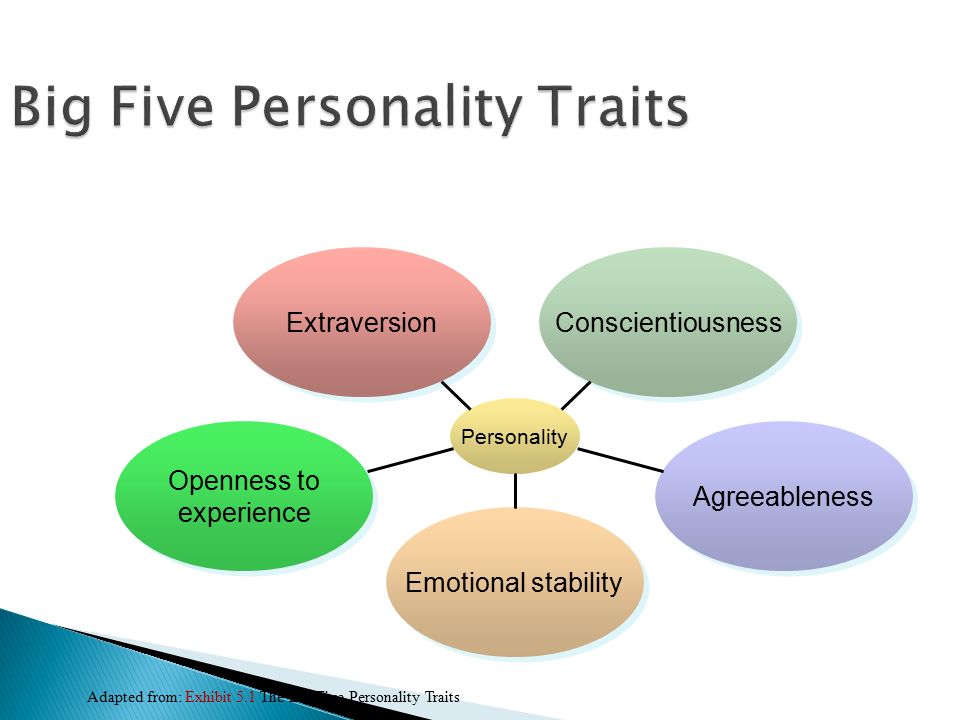 ” Each one reflects a key part of how a person thinks, feels, and behaves. The Big Five traits are:
” Each one reflects a key part of how a person thinks, feels, and behaves. The Big Five traits are:
- Openness to experience (includes aspects such as intellectual curiosity and creative imagination)
- Conscientiousness (organization, productiveness, responsibility)
- Extroversion (sociability, assertiveness; its opposite is Introversion)
- Agreeableness (compassion, respectfulness, trust in others)
- Neuroticism (tendencies toward anxiety and depression)
Individual personalities are thought to feature each of these five broad traits to some degree. When the traits are measured, some people rate higher and others rate lower: Someone can be more conscientious and less agreeable than most people, for instance, while scoring about average on the other traits. These traits remain fairly stable during adulthood.
People can also differ on the more specific facets that make up each of the Big Five traits. A relatively extroverted person might be highly sociable but not especially assertive.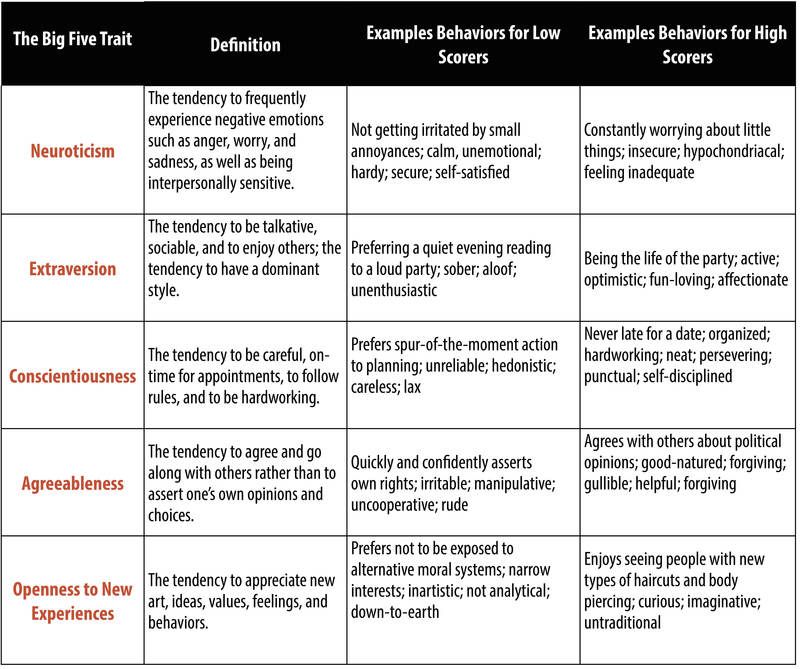
The five-factor model is widely used by personality researchers, but it is not the only model. A more recently introduced six-factor model known as HEXACO adds the factor of honesty-humility to the original five traits.
Contents
- Measuring the Big Five
- Why the Big Five Matter
- Other Personality Tests
How the Big Five Personality Traits Are Measured
The Big Five traits are typically assessed using one of multiple questionnaires. While these tests vary in the exact terms they use for each trait, they essentially cover the same broad dimensions, providing high-to-low scores on each: openness to experience (also called open-mindedness or just openness), conscientiousness, extroversion (the reverse of which is introversion), agreeableness, and neuroticism (sometimes negative emotionality or emotional stability).
One test, the latest version of the Big Five Inventory, asks how much a person agrees or disagrees that he or she is someone who exemplifies various specific statements, such as:
- “Is curious about many different things” (for openness, or open-mindedness)
- “Is systematic, likes to keep things in order” (for conscientiousness)
- “Is outgoing, sociable” (for extroversion)
- “Is compassionate, has a soft heart” (for agreeableness)
- “Is moody, has up and down mood swings” (for neuroticism, or negative emotionality)
Based on a person’s ratings for dozens of these statements (or fewer, for other tests), an average score can be calculated for each of the five traits.
What does your score on the Big Five tell you?
Scores on a Big Five questionnaire provide a sense of how low or high a person rates on a continuum for each trait. Comparing those scores to a large sample of test takers—as some online tests do—offers a picture of how open, conscientious, extroverted (or introverted), agreeable, and neurotic one is relative to others.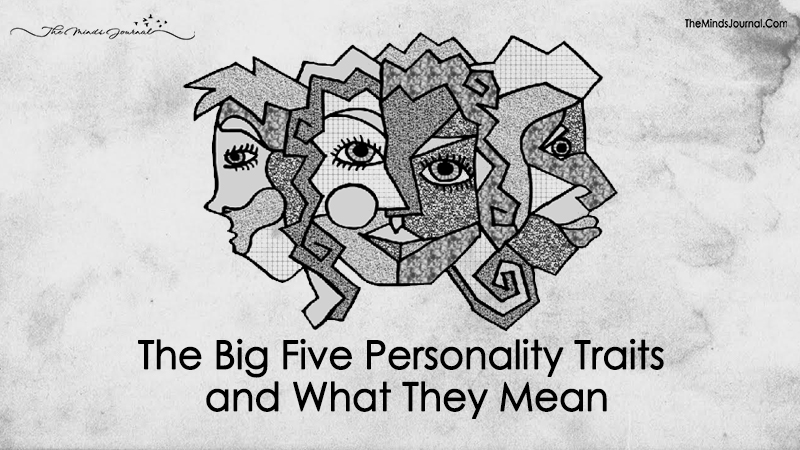
How were the Big Five traits determined?
Analyzing English words used to describe personality traits, researchers used statistical techniques to identify clusters of related characteristics. This led to a small number of overarching trait dimensions that personality psychologists have scientifically tested in large population samples.
Who developed the Big Five personality traits?
The Big Five were not determined by any one person—they have roots in the work of various researchers going back to the 1930s. In 1961, Ernest Tupes and Raymond Christal identified five personality factors that others would reanalyze and rename. Lewis Goldberg used the term Big Five in 1981 to describe these broad factors.
Do Big Five tests measure more specific traits?
Some Big Five questionnaires break the five main traits down into smaller sub-components or “facets,” which are correlated with each other but can be independently measured.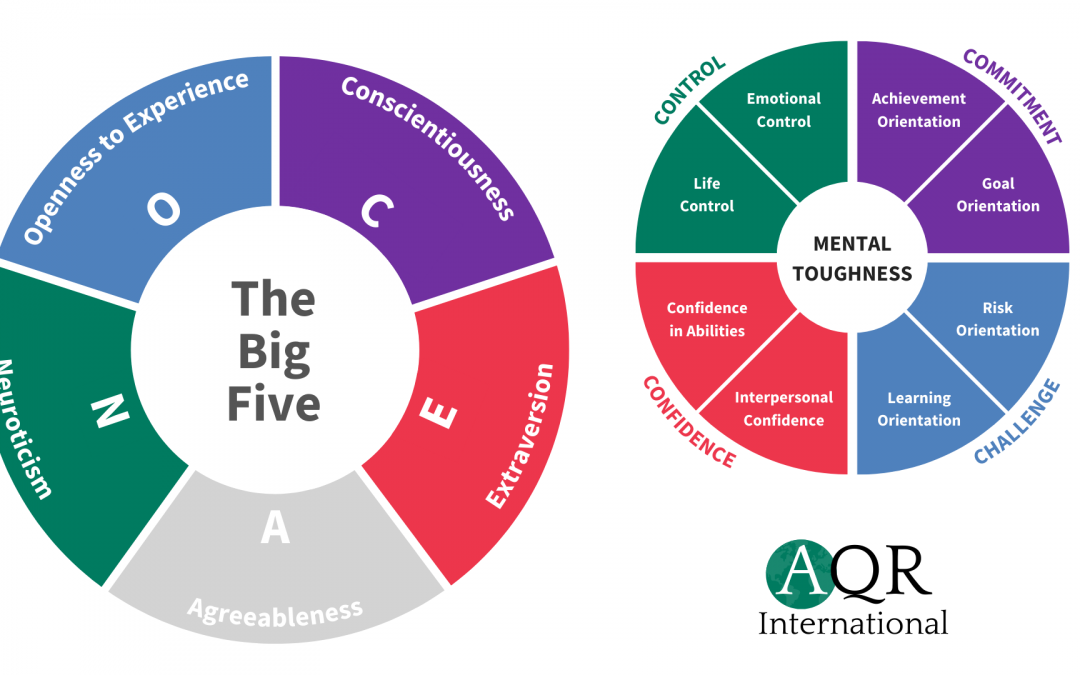 In the Big Five Inventory, for instance, “sociability” and “assertiveness” are distinct facets of extroversion, while “organization” and “responsibility” are facets of conscientiousness.
In the Big Five Inventory, for instance, “sociability” and “assertiveness” are distinct facets of extroversion, while “organization” and “responsibility” are facets of conscientiousness.
Why the Big Five Personality Traits Are Important
The five-factor model not only helps people better understand how they compare to others and to put names to their characteristics. It’s also used to explore relationships between personality and many other life indicators. These include consequential outcomes such as physical health and well-being as well as success in social, academic, and professional contexts. Personality psychologists have observed reliable associations between how people rate on trait scales and how they fare or feel, on average, in various aspects of their lives.
What can Big Five scores tell us about other outcomes?
Quite a lot, at least in Western samples. There is reliable evidence, for example, that extroversion is associated with subjective well-being, neuroticism with lower work commitment, and agreeableness with religiousness. Certain traits have been linked to mortality risk. However, these are overall patterns and don’t mean that a trait necessarily causes any of these outcomes.
Certain traits have been linked to mortality risk. However, these are overall patterns and don’t mean that a trait necessarily causes any of these outcomes.
Can Big Five personality traits change?
Yes. While personality trait measures tend to be fairly consistent over short periods of time in adulthood, they do change over the course of a lifetime. There’s also reason to believe that deliberate personality change is possible.
The Big Five and Other Personality Tests
Various ways of representing major traits have been proposed, and personality researchers continue to disagree on the number of distinct characteristics that can be measured. The five-factor model dominates the rest, as far as psychologists are concerned, although multiple types of assessments exist to measure the five traits.
Outside of academic psychology, tests that aim to sort people into personality types—including the Myers-Briggs/MBTI and Enneagram—are highly popular, though many experts take issue with such tests on scientific grounds.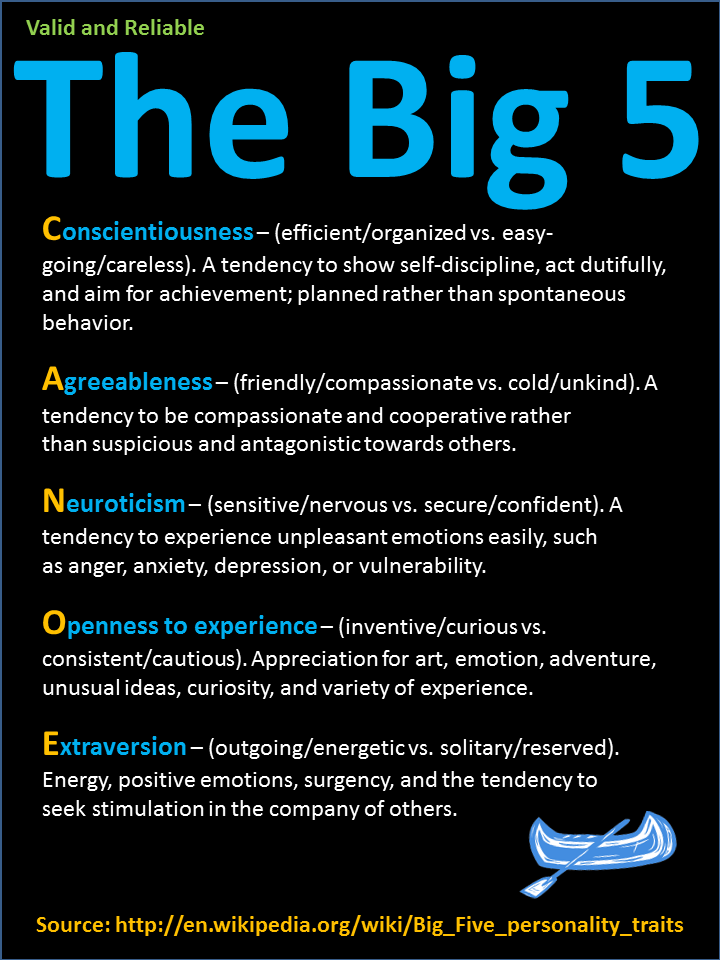 The five-factor model has conceptual and empirical strengths that others lack.
The five-factor model has conceptual and empirical strengths that others lack.
How do Big Five tests compare to the Myers-Briggs?
For a number of reasons, many personality psychologists consider Big Five tests superior to the Myers-Briggs Type Indicator. These include concerns about the reliability of the types assigned by the Myers-Briggs and the validity of the test—though there is some overlap between its dimensions (which include extroversion-introversion) and the Big Five.
Do the Big Five capture personality types?
It depends on how strictly you define a “type.” Research indicates that for any given trait, people fall at various points along a continuum rather than fitting neatly into categories. While some identify wholeheartedly as a total extrovert or introvert, for example, there are many shades in between, and most of us would score somewhere in the middle.
Do Big Five tests have known limitations?
Yes. Some have criticized the five-factor model for its origins in data rather than in theory and argued that it does not encompass all fundamental traits (see HEXACO). There is also evidence that current tests provide less reliable results outside of Western, industrialized countries.
Essential Reads
Recent Posts
The best qualities of a person - a list of the best character traits
Each person has positive and negative qualities that determine the character, attitude to the world around. The character of each is different, personal human qualities are important components, bringing them together, you can see the psychological image. Personal qualities are divided into two groups:
- positive
- negative
Consist entirely of positive, no one can be the best, but they certainly must prevail.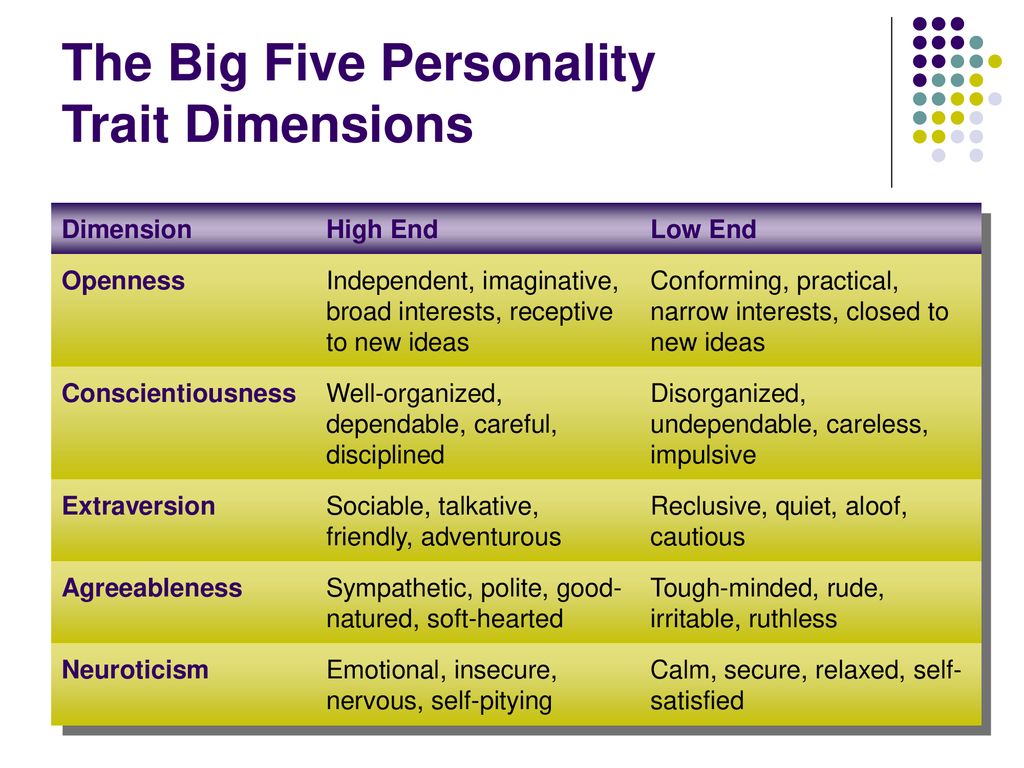 You can work better on yourself, eradicate bad sides, improve good traits in character and behavior. Negative properties often spoil life, the attitude of others, affect success, provide a better position in society.
You can work better on yourself, eradicate bad sides, improve good traits in character and behavior. Negative properties often spoil life, the attitude of others, affect success, provide a better position in society.
List of the best qualities in a person's character
- Kindness is the best property of the soul.
- Honesty is a valuable character trait.
- Loyalty is an important personality trait.
- Responsiveness - sympathy for society and help.
- Generosity is an unselfish trait of character.
- Humor is a positive and better outlook on life.
Kindness is one of the best character traits
From childhood, a child is taught to be kind, to love animals, to help people, to do only positive things. There are a myriad of sayings, proverbs about kindness, children learn them at school. Our ancestors invented proverbs in order to make the world a better place. Unfortunately, not everyone has this best feature, one of the most successful for a happy life. A good-natured person is ready to help disinterestedly, does not want evil, there is no envy in him. This can be brought up in oneself if a person feels that he is envious, demanding, he definitely needs to work on himself, eradicate negative traits and instill better, positive ones.
A good-natured person is ready to help disinterestedly, does not want evil, there is no envy in him. This can be brought up in oneself if a person feels that he is envious, demanding, he definitely needs to work on himself, eradicate negative traits and instill better, positive ones.
You will also be interested to know:
- The richest person in the world
- The oldest person in the world
- The fastest person in the world
- The dirtiest and cleanest cities in Russia
- The largest planet in the solar system
- responsiveness;
- disinterestedness;
- attentiveness to others;
- goodwill;
- friendliness.

- fidelity;
- truthfulness;
- sincerity.
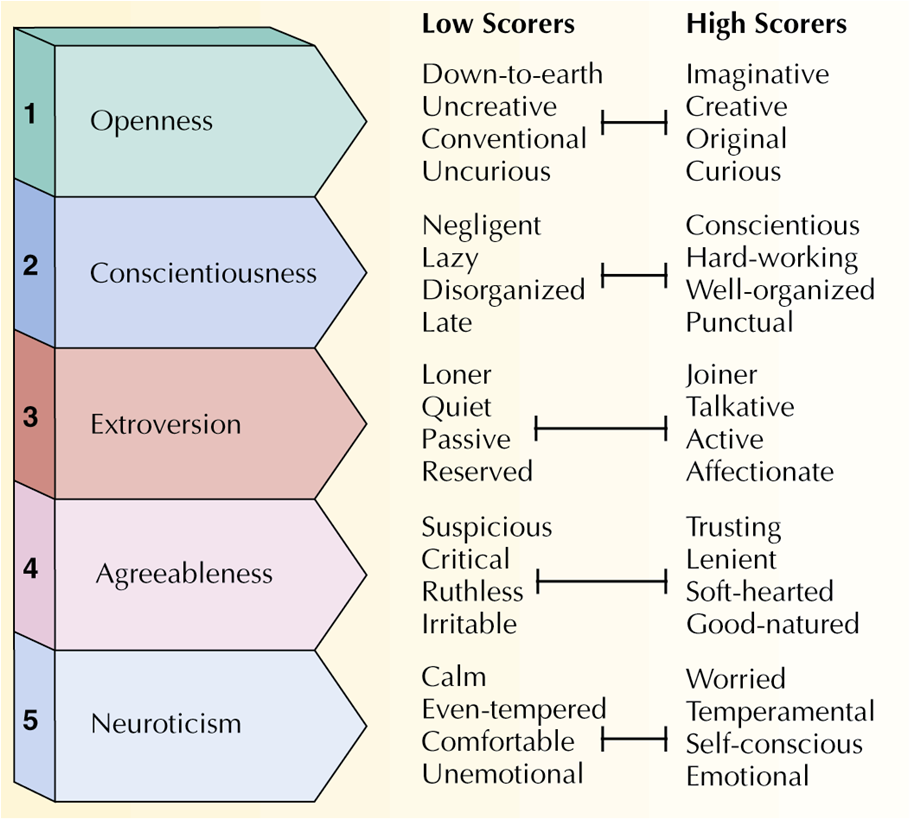
- Diligence-laziness . This “duet” can be both a character trait and express an attitude towards a particular work. A constant feeling of laziness can also indicate that a person is simply not interested in the business he is busy with, but in something else, he will prove himself better. Laziness can be a sign of insufficient motivation for life. But excessive diligence also takes on a degree of workaholism, which can also indicate problems in personal relationships, a lack of interests.
- Liability-irresponsibility . One of the most important qualities for an employee. A person who responsibly performs his duties, does not let his colleagues down, will be a valuable employee.

- Good faith-bad faith . Doing duty and doing it well are not the same thing. It is important for management that diligence is expressed not only in the mechanical performance of actions, but brings results.
- Initiative-passivity . This quality is especially valuable for people who want to move up the career ladder. If an employee does not show initiative, does not generate ideas, hides behind the backs of colleagues, he will not develop in his profession.
- Closeness-sociability . It shows the openness of a person, his looseness, how easy it is for him to make acquaintances, how he feels in a new company, team.
- Truthfulness-Falsehood . Pathological liars lie even in trifles, hide the truth, easily betray. There are people who embellish reality, most often they do it because reality seems boring or not bright enough to them.
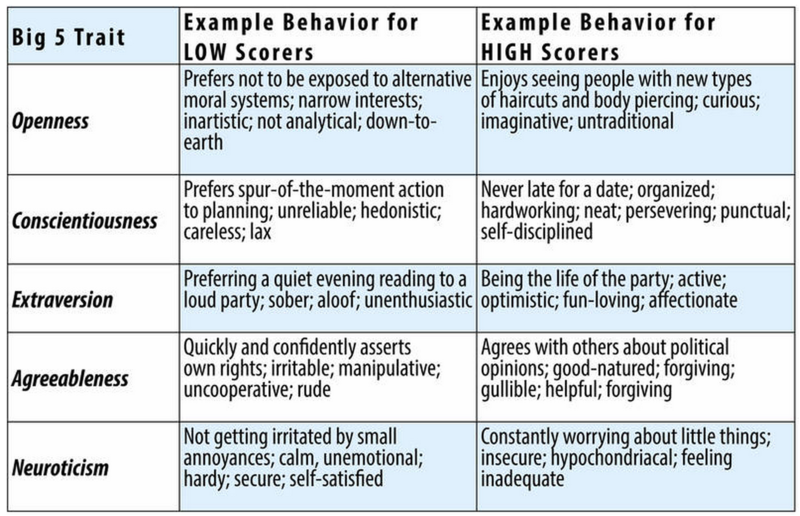
- Self-conformity . This quality shows how a person makes decisions. Whether he relies on his experience, knowledge, opinion, or follows someone's lead and it is easy to suppress him.
- Rudeness-politeness . Anger, inner feelings make a person cynical, rude. Such people are rude in queues, public transport, disrespectful to subordinates. Politeness, although it refers to positive character traits, can have a selfish background. It can also be an attempt to avoid confrontation.
- Neatness-slovenliness . Creative mess or meticulous cleanliness in the house can show how neat a person is. You can also characterize it by its appearance. Sloppy people often arouse antipathy, and there are not always those who want to see a broad soul behind external absurdity.
- Thrift-Negligence . You can evaluate a person by his attitude to the accumulated property, borrowed items.
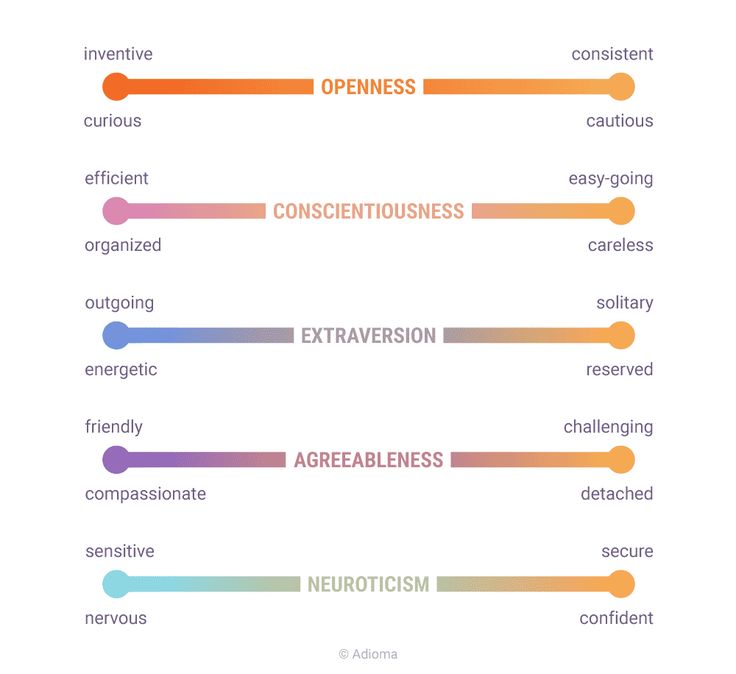 Although this trait of a person ended up in the material group, it can also manifest itself in relation to people.
Although this trait of a person ended up in the material group, it can also manifest itself in relation to people. - Greed-generosity . To be called generous, it is not necessary to be a philanthropist or give the last. At the same time, excessive generosity is sometimes a sign of irresponsibility or an attempt to "buy" someone else's favor. Greed is expressed not only in relation to other people, but also to oneself, when a person, out of fear of being left without money, saves even on trifles.
- Demandingness . When this personality trait is clearly expressed, two extremes appear. A person who is demanding of himself is often just as strict with others. He lives by the principle "I could, so others can." He may be intolerant of other people's weaknesses, not realizing that each person is individual. The second extreme is built on uncertainty. A person tortures himself, considering himself insufficiently perfect.
 A striking example is anorexia, workaholism.
A striking example is anorexia, workaholism. - Self-criticism . A person who knows how to criticize himself has a healthy self-esteem. Understanding, accepting and analyzing your achievements and defeats helps in the formation of a strong personality. When the balance is disturbed, either egocentrism or self-blame is observed.
- Modesty . It must be understood that modesty and shyness are different concepts. The first is based on the value system instilled during education. The second is a call to the development of complexes. In a normal state, modesty is manifested in moderation, calmness, knowledge of the measure in words, expression of emotions, financial spending, etc.
- Egoism and egocentrism . Similar concepts, but the feature here is egoism, but egocentrism is a way of thinking. Egoists think only of themselves, but use others for their own purposes. Egocentrics are often misanthropes and introverts who do not need others, who believe that no one is worthy of them.
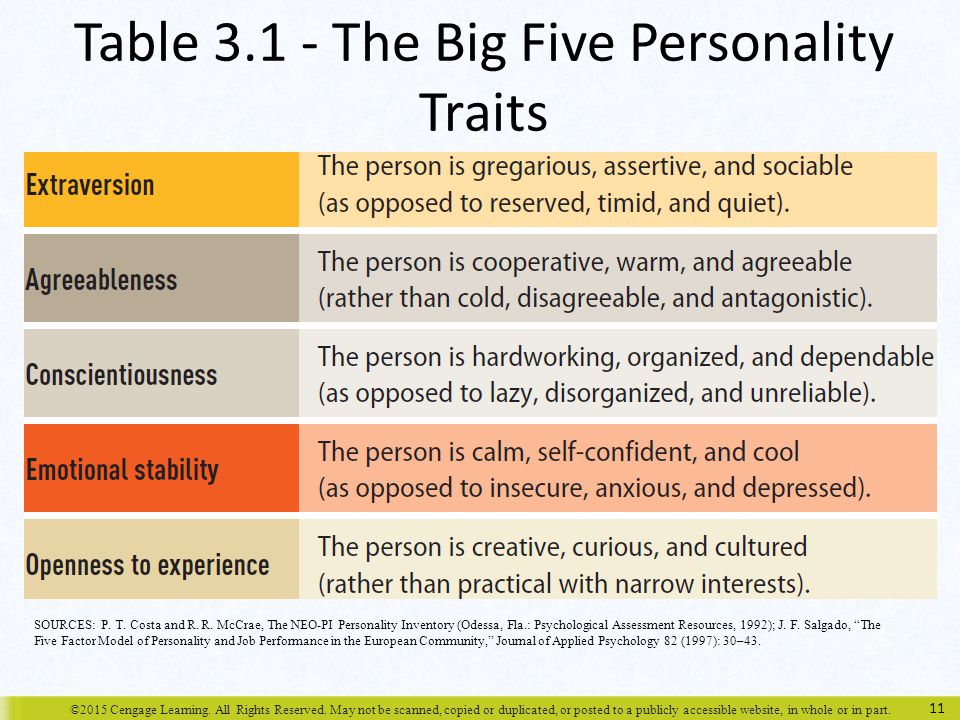
- Self-esteem . Shows how a person feels internally. Outwardly, it is expressed in a high assessment of their rights and social value.
- Intellectual. Resourcefulness, curiosity, frivolity, practicality.
- Emotional. Passion, sentimentality, impressionability, irascibility, cheerfulness.
- Strong-willed. Courage, perseverance, purposefulness.
- Moral. Justice, responsiveness, kindness.
- Dominant . They determine the behavior of the individual as a whole, regardless of the sphere, and at the same time influence other qualities or even overlap them. For example, kindness or greed.
- Ordinary . They are also expressed in all spheres of life. These include, for example, humanity.
- Minor . They do not particularly affect anything, often stemming from other traits. For example, diligence.
- Weak. Formality, irritability, shyness, impulsiveness, inability to remain silent or say "no".
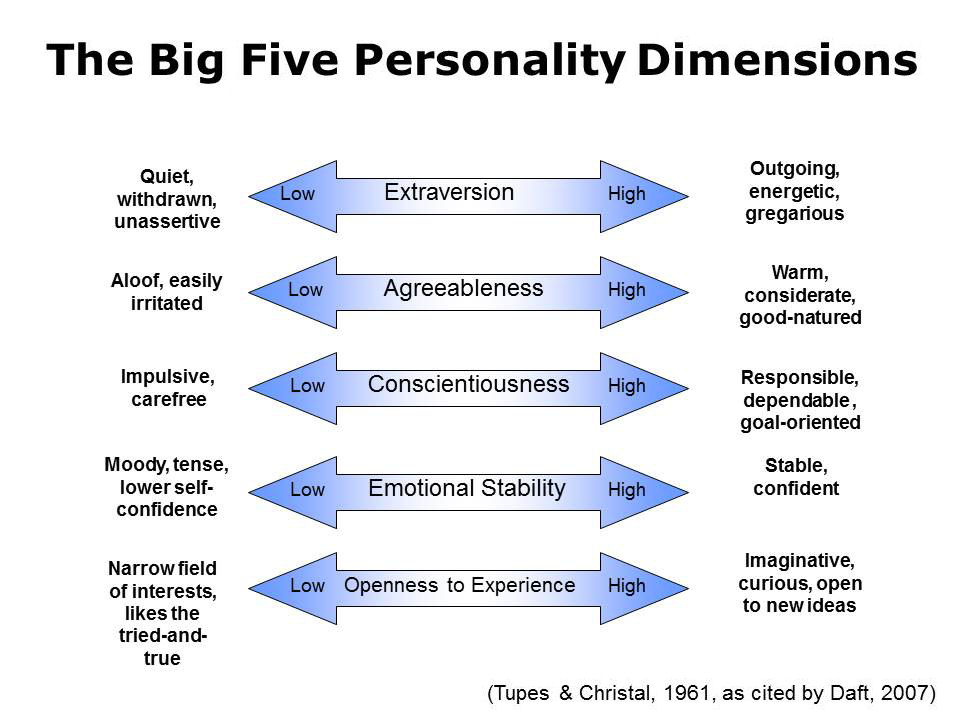
The word comes from "good", which means good. Hence the understanding that a good-natured person brings good, helps others. Such people are affectionate with everyone, take care of the elderly, children in need, treat the world better. Mandatory Goodhearted Companions:
People around you will certainly appreciate such a disposition towards themselves, they will help in return, they will appreciate it better. People who are not characterized by kindness mistakenly believe that it is better to think only about themselves, that there are no sympathetic, grateful people around who will be mutual. Very often, an evil person just made a mistake, got burned and lost confidence in people. All this can be corrected by showing your neighbor your positive attitude, accompanied by the above-mentioned best manners.
Honesty is the positive side of character
One of the best human virtues is honesty. It is very much appreciated by others, it helps to reflect the most important requirement of morality. An honest person will be better appreciated, respected, it is pleasant to work with him, communicate, because he does not lie, does not hypocrite, does not betray. Honesty includes such traits as:
An honest person respects himself and others, is devoted to his accepted obligations, is convinced that he is doing the right, good deed, telling the truth to others. First of all, honesty is sincerity to oneself, such people are self-confident, invariably live in harmony with their conscience, have a strong disposition, self-confidence, and respect others. Honest is open to others, does not allow deception in communication with others. This is one of the best qualities that speaks of decency and morality. Most people prefer to communicate, work, make friends, choose honest personalities as their life partners. Sometimes you can hear an unpleasant truth from an honest person, but this is much better than hearing a pleasant lie. However, honesty is not an innate quality, but acquired during upbringing. It is necessary to form it from early childhood, the responsibility for this lies with the child's family.
Loyalty is the key to happiness
Loyalty is one of the most important qualities of a person.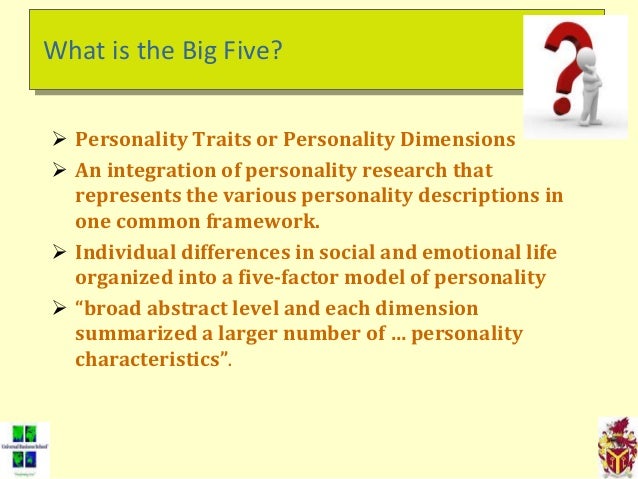 You can look at this best trait from different angles, there are different types of fidelity. Such a trait of character denotes immutability, steadfastness of feelings, gaze during the performance of one's duties, duty. A faithful person, after making a decision once, always follows his choice, despite doubts. Loyalty is shown to a friend, loved one, family, homeland, beliefs, principles, a given word.
You can look at this best trait from different angles, there are different types of fidelity. Such a trait of character denotes immutability, steadfastness of feelings, gaze during the performance of one's duties, duty. A faithful person, after making a decision once, always follows his choice, despite doubts. Loyalty is shown to a friend, loved one, family, homeland, beliefs, principles, a given word.
An error leads to its destruction, it can be accidental or conscious. This is already called betrayal, manifested to oneself, to the rules, to a person. Treason and violation of devotion always leads to losses of a moral, physical nature. A person experiences it in different ways, it all depends on the situation. Marital devotion implies devotion, care for the spouse, submission, sharing of his interests. If one of the spouses cheats, most likely, such a relationship will be destroyed forever. After all, the one who was betrayed will lose confidence, which means that a positive opinion about another person is destroyed.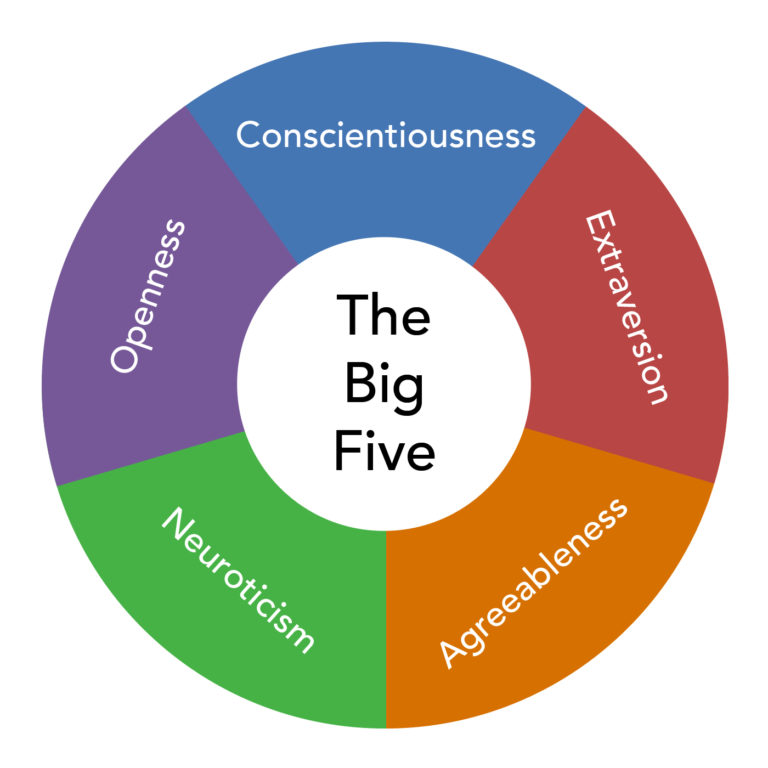
Responsiveness is one of the best virtues
One of the important spiritual and moral qualities of a person is responsiveness. The trait is characterized by the fact that a responsive person is always ready to help his neighbor, to come to the rescue at any time, and to do this without self-interest. The advantage of such a human trait: a kind attitude towards others, self-perception of one's own personality as sincere, disinterested.
In general, this concept is complex, it is impossible to explain it in a nutshell. It is directly related to the psychology of the individual, when she is able to understand the importance of other people's problems, accept their characteristics, come to the rescue, even if she is not asked. A responsive person knows how to sincerely sympathize, empathize with everyone, respects, appreciates people, shows the best towards them: cordiality, kindness, friendliness.
Responsiveness is a rare quality, therefore it is highly valued by people, it is one of the best.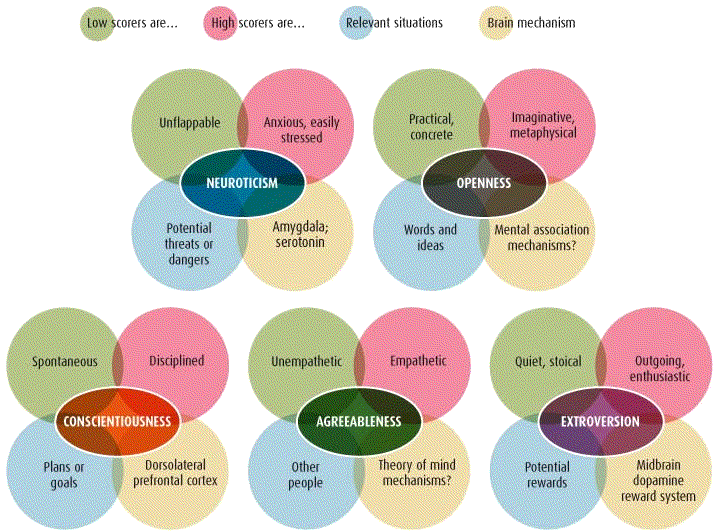 After all, not everyone is ready to give up everything and devote their strength, time, and sometimes resources to solving the problems of another. A person with a high level of responsiveness helps from the bottom of his heart, does not do bad deeds towards others.
After all, not everyone is ready to give up everything and devote their strength, time, and sometimes resources to solving the problems of another. A person with a high level of responsiveness helps from the bottom of his heart, does not do bad deeds towards others.
Education influences this best character trait. In the child's worldview, it is made up of what he receives in childhood, from the family, school. The basis of formation: parents, their demonstration of attitude to nature, others, animals. It is important to cultivate compassion, kindness, respect and empathy in a child. All this together develops into responsiveness.
Generosity - noble deeds
One of the best qualities of human nature is its ability to render selfless help to others in the necessary measure. Generosity also manifests itself in gifts, charity, the ability to share. This is a sign of generosity and kindness itself, a wonderful character trait that needs to be developed. A generous person receives in return warmth, happiness, joy for others.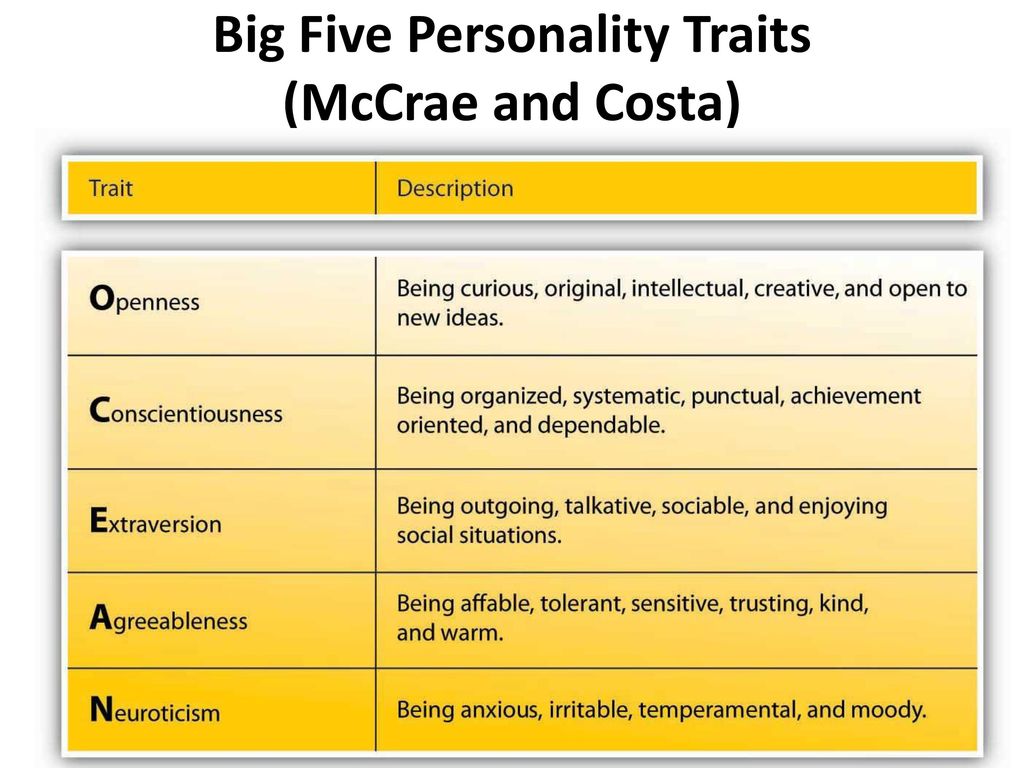 Realizes that helping another is an additional step towards making the world a better place, does not limit your happiness with resources.
Realizes that helping another is an additional step towards making the world a better place, does not limit your happiness with resources.
Generosity is one of the best forms of kindness, the opposite of selfishness, one of the worst aspects of character.
Generosity is manifested not only in the giving of material goods, but also in the donation of one's strength and time. There are people in the world who simply cannot live comfortably knowing that it is difficult for someone, they want to help and make their life better. They are ready to share what they have right here and now, and not sometime when their situation is better than today. Timely, albeit small, generosity is much more valuable, better than large, but belated.
Humor is the ability to live positively
A sense of humor shows the capabilities of the human intellect, the ability to assess situations, to better notice the features and contradictions of the surrounding world. A person with a good sense of humor will be able to notice, evaluate the contradictions of the surrounding world from a comic point of view.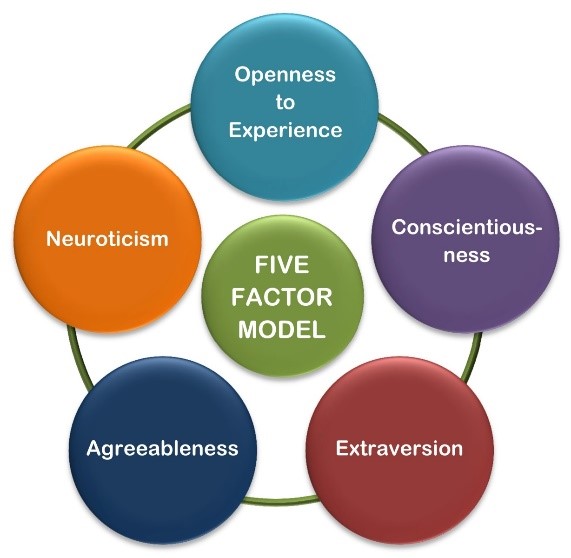 The development and manifestation of this characteristic feature begins in childhood.
The development and manifestation of this characteristic feature begins in childhood.
Humor in many ways serves as the best psychological defense, sometimes it becomes easier to go through difficult life moments if you look at them from a humorous point of view. It is always easier, better and more interesting to communicate with people who understand jokes and react positively to them, because they themselves can joke, cheer up others.
Read more:
What to do if your life is an endless "Groundhog Day"
what are and how to evaluate them?
Features of behavior, communication, attitude to people, objects, work, things show the character traits that an individual possesses. According to their totality, an opinion about a person is determined. Such clichés as "the soul of the company", "bore", "pessimist", "cynic" are the result of an assessment of a person's character traits. Understanding how character is structured helps in building relationships.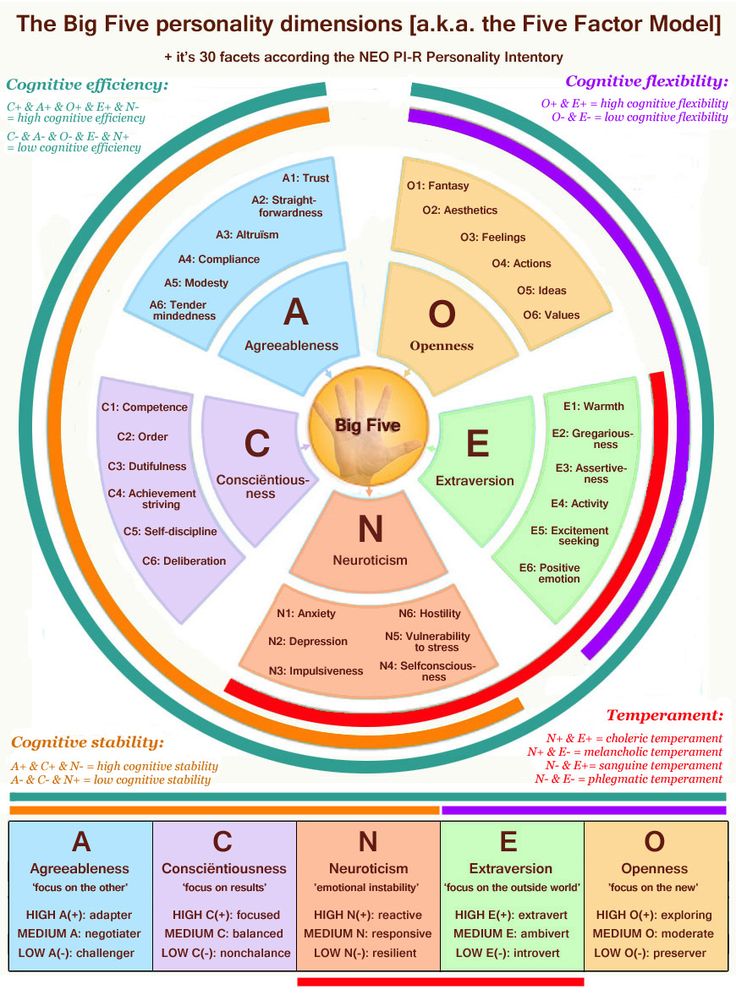 And this applies to both their own qualities and others.
And this applies to both their own qualities and others.
Classification of characters.
Character is determined by predominant traits, which in turn influence behavior and actions. They can be considered in the system of relations to work, other people, things, and oneself.
1. Labor
Take a personality test
2. Other people
3. Things
4. Self
Take the test: introvert or extrovert?
Evaluation of personality and types of characters.
In addition to the main character traits that are formed in the system of relationships, psychologists also distinguish other areas:
There are motivational traits-goals that drive a personality and determine its guidelines. As well as instrumental traits-methods, they show exactly what methods the desired will be achieved. So, for example, a girl can manifest masculine qualities of character when she persistently and proactively seeks her lover.
So, for example, a girl can manifest masculine qualities of character when she persistently and proactively seeks her lover.
About what are the traits of character, put forward the theory of Gordon Allport. The psychologist divided them into the following types:
There are typical and individual personality traits. Typical ones are easy to group, noticing one of the dominant qualities or a few minor ones, you can “draw” a personal portrait as a whole, determine the type of character. This helps to predict actions, better understand a person. So, for example, if an individual has responsiveness, then most likely he will come to the rescue in a difficult situation, support, listen.
This helps to predict actions, better understand a person. So, for example, if an individual has responsiveness, then most likely he will come to the rescue in a difficult situation, support, listen.
Positive and negative character traits.
Personality is a balance of positive and negative qualities. In this regard, everything is conditional. For example, envy is considered a bad quality, but some psychologists argue that it can become an incentive to work on yourself or improve your life. The distortion of positive traits, on the contrary, can lead to their transformation into negative qualities. Persistence develops into obsession, initiative into self-centeredness.
Strong and weak character traits should be highlighted, they often have to be remembered when filling out a resume. They terrify many, because it can be difficult to evaluate oneself. Here, a small "cheat sheet":
